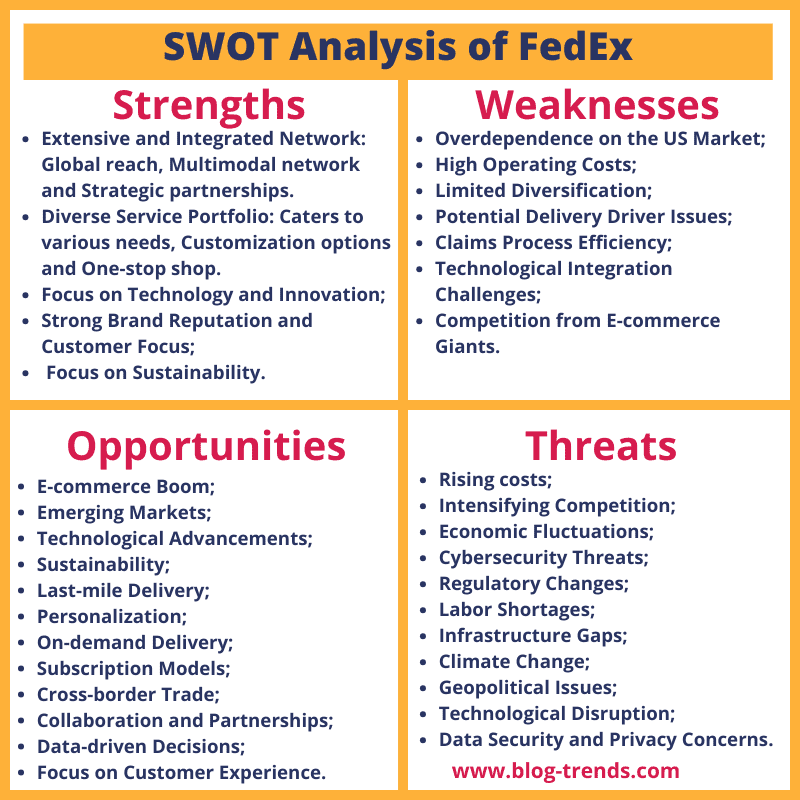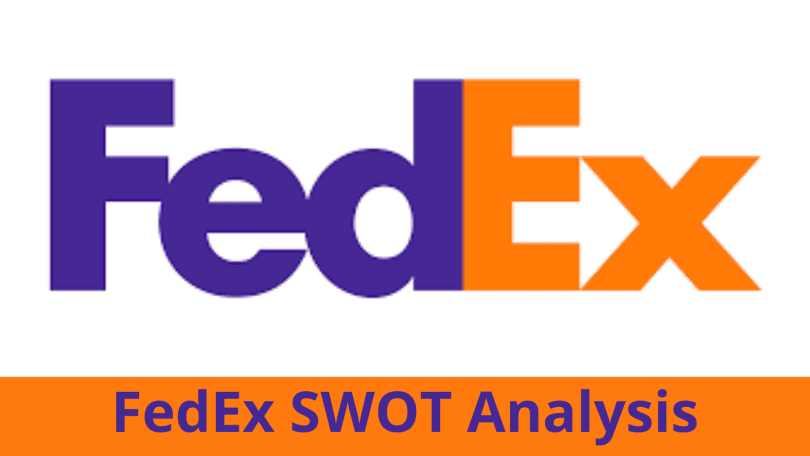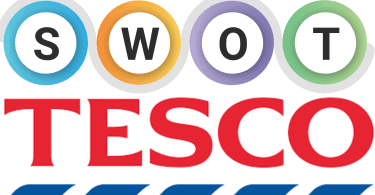In the dynamic world of global logistics, strategic decision-making is the cornerstone of success, and for an industry leader like FedEx, understanding the complexities of its internal capabilities and external environment is crucial.
Welcome to our exploration of FedEx’s SWOT analysis for 2024, where we illuminate the significance of this strategic tool for the company’s management.
Delving into FedEx’s strengths, weaknesses, opportunities, and threats, this analysis serves as a compass for management, offering a comprehensive understanding of the company’s current standing.
By evaluating internal capacities and external factors, this SWOT analysis provides FedEx’s leadership with the insights necessary to chart a course that maximizes strengths, mitigates weaknesses, capitalizes on opportunities, and navigates potential threats.
FedEx overview
Origins and Evolution:
- Founded in 1971 by Frederick W. Smith with a vision for overnight delivery.
- Started with 14 jets and 389 packages, operating within the US.
- Grew through organic expansion and strategic acquisitions, like TNT Express in 2016.
- Today, it’s a multinational conglomerate with diverse services.
Spectrum of Services:
- FedEx Express: Time-definite deliveries, including overnight and international options.
- FedEx Ground: Cost-effective ground shipping solution for less urgent needs.
- FedEx Freight: Handles larger cargo through less-than-truckload (LTL) and truckload freight services.
- FedEx Supply Chain: Provides end-to-end supply chain management solutions for businesses.
- FedEx Office: Offers printing, copying, and shipping services through retail locations.
Navigating the Competitive Landscape:
- Key competitors include United Parcel Service (UPS), DHL, and Deutsche Post.
- Competition intensifies in e-commerce and international markets, driving innovation and cost reductions.
- FedEx differentiates itself through:
- Extensive global network;
- Diverse service portfolio;
- Focus on technology and automation.
A World-Spanning Network:
- Operates in over 220 countries and territories, offering global reach.
- Possesses a vast air and ground network, facilitating seamless movement of goods.
- Strategic partnerships with other carriers further expand its reach and service offerings.
The Power of People:
- Over 600,000 employees represent a diverse and multicultural workforce.
- Strong focus on employee training and development to maintain a skilled workforce.
- Employees are considered the backbone of FedEx’s success and customer satisfaction.
Serving Diverse Customers:
- Caters to individuals, businesses of all sizes, and e-commerce merchants.
- Prioritizes customer satisfaction and loyalty through reliable service and personalized solutions.
- Technology empowers customers with convenient tools for tracking, shipping management, and online solutions.
Charting the Course:
- Focuses on growth in e-commerce and international expansion to capture emerging markets.
- Invests in automation and sustainability initiatives to optimize operations and reduce environmental impact.
- Commits to continuous innovation and enhancing customer experience through cutting-edge solutions.
Key Figures (as of February 2024):
- Sales: $93.5 billion (Fiscal Year 2023)
- Number of countries served: 220+
- Employees: 600,000+
- Aircraft fleet: 693 (including owned and leased).
Now, let’s jump into the swot analysis results of FedEx!
The internal analysis of FedEx
The main goal of an internal analysis for FedEx is to gain a deep understanding of its strengths and weaknesses, by evaluating its internal factors.
This self-assessment helps FedEx management make informed decisions and develop effective strategies for the future.
The strengths of FedEx
According to our investigation, FedEx boasts several strengths that give it an edge over its direct competitors:
Extensive and Integrated Network:
- Global reach: Operates in over 220 countries and territories, offering more comprehensive market access than many competitors.
- Multimodal network: Combines air, ground, and ocean transportation capabilities for flexible and efficient delivery solutions.
- Strategic partnerships: Collaborates with other carriers, expanding reach and service offerings beyond its network.
Diverse Service Portfolio:
- Caters to various needs: Offers a wide range of services, from time-definite express deliveries to cost-effective ground shipping and specialized supply chain solutions.
- Customization options: Provides tailored solutions to individual customer needs and industry requirements.
- One-stop shop: Customers can access multiple services through a single provider, simplifying logistics management.
Focus on Technology and Innovation:
- Advanced tracking systems: Offers real-time shipment visibility and tracking tools for enhanced customer experience.
- Automation and robotics: Invests in automation technologies to improve efficiency, accuracy, and cost-effectiveness.
- E-commerce solutions: Provides integrated e-commerce shipping solutions for businesses of all sizes.
Strong Brand Reputation and Customer Focus:
- Reliability and trust: Recognized for its consistent performance and commitment to service quality.
- Customer-centric approach: Prioritizes customer satisfaction through personalized solutions and responsive support.
- High investment in employee training: Maintains a skilled and dedicated workforce, leading to better customer service.
Focus on Sustainability:
- Environmental initiatives: Implements green practices to reduce carbon footprint and promote sustainability.
- Alternative fuel vehicles: Invest in electric and hybrid cars for cleaner transportation solutions.
- Sustainable packaging: Develops innovative packaging solutions to minimize waste and environmental impact.
While competitors like UPS and DHL offer similar services, FedEx’s strengths lie in its broader network, diverse offerings, technological advancements, customer focus, and commitment to sustainability.
These factors enable them to cater to a broader range of customers, differentiate themselves in the market, and adapt to evolving industry trends.
The weaknesses of FedEx
Despite its strengths, FedEx also has some weaknesses compared to its competitors:
Overdependence on the US Market:
A large portion of FedEx’s revenue comes from the US market, making it vulnerable to economic fluctuations there. Its international expansion, while significant, may not be as extensive as some competitors like DHL.
High Operating Costs:
The logistics industry requires high fixed and variable costs for fuel, labor, and infrastructure. This can put pressure on profitability, especially if competitors can manage costs more effectively.
Limited Diversification:
While offering a range of services, FedEx may not be as diversified as some competitors who venture into areas like financial services or healthcare logistics. This could limit growth potential in emerging markets or industries.
Potential Delivery Driver Issues:
Some customers report instances of improper package handling, rude behavior, or unreliable delivery times by drivers, impacting brand perception.
Claims Process Efficiency:
Some customers express dissatisfaction with the speed and ease of resolving claims for damaged or lost packages.
Technological Integration Challenges:
Integrating various internal and external systems across a vast network can be complex and lead to inefficiencies.
Competition from E-commerce Giants:
Companies like Amazon are building their own logistics infrastructure, potentially posing a threat to traditional third-party logistics providers like FedEx.
While these weaknesses exist, FedEx actively works to address them. They are investing in international expansion, cost-reduction initiatives, technology upgrades, and driver training programs.
However, staying ahead of the competition requires constant vigilance and strategic adaptation.
The external analysis of FedEx
The primary objective of conducting an external analysis for FedEx is to understand external factors beyond its control that could influence its success.
This analysis helps FedEx management in making well-informed decisions regarding its strategy, operations, and future trajectory. The external analysis delves into two main aspects: opportunities and threats.
Let’s move on to FedEx’s current and potential opportunities and threats without further ado.
The opportunities of FedEx
Opportunities refer to favorable external factors that FedEx can leverage to achieve its goals and gain a competitive advantage.
These are factors that arise outside the company’s control but present potential for positive change if exploited strategically.
The global delivery market is brimming with exciting opportunities, driven by several key trends:
E-commerce Boom:
This continues to be a significant driver, with increasing online shopping leading to a surge in parcel deliveries. This presents opportunities for players like FedEx to expand e-commerce-specific services and cater to diverse needs.
Emerging Markets:
Rapidly growing economies in Asia, Africa, and Latin America present vast potential for expansion. Companies such as FedEx can tap into the rising demand for delivery services in these regions.
Technological Advancements:
Drones, autonomous vehicles, robotics, and artificial intelligence are revolutionizing logistics. Embracing these technologies can optimize operations, improve efficiency, and create new delivery options.
Sustainability:
Growing consumer and regulatory pressure drives the need for sustainable delivery solutions. Companies can capitalize on this by offering eco-friendly packaging, alternative fuel vehicles, and carbon-neutral options.
Last-mile Delivery:
Optimizing the final leg of delivery to customer doorsteps remains a challenge. Innovative solutions like micro-fulfillment centers, intelligent lockers, and crowd-sourced delivery can address this gap.
Personalization:
Customers increasingly expect customized delivery experiences. Offering flexible delivery options, real-time tracking, and personalized communication presents lucrative opportunities.
On-demand Delivery:
Growing demand for instant deliveries within minutes or hours creates opportunities for specialized services catering to fast-paced urban environments.
Subscription Models:
Subscription-based delivery services for everyday essentials or specialized products are gaining traction, offering recurring revenue streams and customer loyalty.
Cross-border Trade:
Simplifying and streamlining cross-border delivery processes, especially with complex regulations, can attract businesses entering new markets.
Collaboration and Partnerships:
Strategic partnerships with other players in the logistics ecosystem, such as retailers or tech companies, can expand reach, offer bundled services, and improve efficiency.
Data-driven Decisions:
Leveraging data analytics to optimize routes, predict demand, and personalize services can provide a significant competitive advantage.
Focus on Customer Experience:
Delivering exceptional customer service through convenient tracking tools, prompt issue resolution, and personalized communication enhances brand loyalty and attracts new customers.
Companies that successfully identify, adapt to, and capitalize on these trends are well-positioned for continued growth and success.
Also, it’s important to know that the market is dynamic, and competition is fierce. Therefore, constant analysis, proactive adaptation, and strategic planning are crucial for turning these opportunities into tangible results.
The threats of FedEx
While brimming with opportunities, the global delivery market also faces several significant threats and risks. Here’s an overview:
Rising Costs:
Fuel prices, labor costs, and infrastructure maintenance pressure profit margins. Companies like FedEx need to find ways to optimize operations and control costs efficiently.
Intensifying Competition:
Traditional players like FedEx face competition from new entrants, e-commerce giants building logistics networks, and tech startups offering innovative solutions.
Economic Fluctuations:
Global economic downturns like the COVID-19 crisis can lead to decreased demand for delivery services, impacting revenue and profitability. Companies need resilience and diversification to weather such storms.
Cybersecurity Threats:
The increasing reliance on technology exposes delivery companies to cyberattacks that can disrupt operations, steal data, and damage reputation. Robust cybersecurity measures are crucial.
Regulatory Changes:
Evolving regulations regarding data privacy, labor laws, and environmental standards can increase compliance costs and operational complexity. Adaptability and proactive engagement with regulatory bodies are key.
Labor Shortages:
Finding and retaining skilled labor, especially drivers, can be challenging in some regions. Investing in workforce development and offering competitive compensation are essential.
Infrastructure Gaps:
Inadequate infrastructure, especially in developing countries, can lead to inefficiencies and delivery delays. Collaborating with governments and investing in infrastructure improvements can mitigate this risk.
Climate Change:
Extreme weather events and natural disasters can disrupt transportation networks and damage infrastructure, impacting delivery capabilities. Building climate resilience and incorporating sustainability practices are crucial.
Geopolitical Issues:
Trade wars, political instability (Houthi attacks in the Red Sea, the war in Ukraine and Palestine), and sanctions can disrupt supply chains and create logistical challenges. Diversifying markets and trade partners can reduce dependence on volatile regions.
Technological Disruption:
While technology offers opportunities, rapid advancements can disrupt existing business models. Companies must be agile and adaptable to embrace new technologies without being left behind.
Data Security and Privacy Concerns:
Customers are increasingly concerned about data security and privacy in the digital age. Implementing robust data protection measures and transparent privacy policies is critical to maintaining trust.
Reputational Risk:
Negative publicity due to delivery delays lost packages, or poor customer service can damage brand reputation and customer loyalty. Investing in service quality and effective communication is essential.
Proactive risk management, strategic planning, and continuous adaptation are essential for companies to navigate these challenges and ensure sustainable growth in the long run.
It’s important to note that the specific threats and their impact can vary depending on the company, region, and market segment. Therefore, a comprehensive risk assessment tailored to the context is crucial for effective mitigation strategies.
SWOT Analysis Matrix of FedEx
To summarize the results of the FedEx SWOT analysis, we present the following SWOT matrix:

Conclusion
In the ever-evolving global logistics landscape, the depth and breadth of strategic decision-making at FedEx necessitate a holistic approach.
While our exploration into the SWOT analysis for 2024 has shed light on internal strengths, weaknesses, external opportunities, and threats, it is crucial to acknowledge that a comprehensive understanding demands the synergy of multiple strategic diagnostic tools.
Incorporating models such as the VRIO framework, PESTEL analysis, and Michael Porter’s Five Forces model enriches the strategic landscape, providing nuanced perspectives on resources, environmental factors, and industry dynamics.
Furthermore, the industry’s dynamic nature underscores the importance of regular SWOT analyses. As the global logistics arena continues to evolve, a periodic revisit to the SWOT analysis ensures that strategic decisions remain aligned with the current reality.
In conclusion, the synergy of SWOT analysis with other strategic diagnostic tools and a commitment to regular reassessment equips FedEx with a comprehensive strategic toolkit.
This, in turn, empowers the company’s leadership to navigate uncertainties, capitalize on emerging opportunities, and fortify its position as a stalwart in the global logistics landscape.”
SWOT Analysis Examples 2024
There is no better way to understand how to conduct a SWOT analysis at your company than with a concrete example.
Below you will find our free, up-to-date, and concrete examples of SWOT analyses of large companies and multinationals conducted in 2024.












Leave a Comment